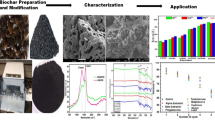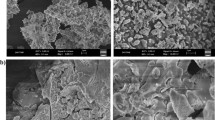Abstract
In this study, the biochar produced from coffee wastes and eucalyptus sawdust was employed as an adsorbent in solid-phase extraction devices for the determination of 17β-estradiol from aqueous solution. Parameters such as adsorbent mass, solvent type, eluent volume, ionic strength, breakthrough volume, and the cartridge reuse were evaluated. The best experimental conditions for solid-phase extraction concerning adsorbent mass, elution solvent, eluent volume, ionic strength, breakthrough volume, and cartridge reuse were established. The most suitable conditions for 1.0-mL cartridge were: mass of 50 mg, elution solvent 5.0 mL of acetonitrile/water 90:10 (v:v), 0.003 mol L−1 NaCl concentration, and 17β-estradiol solution volume 50.0 mL. The solid-phase extraction results showed that, although 17β-estradiol recovery was about 60%, the removal efficiency was 100% and the cartridges of 200 and 500 mg can be reused eight and four times, respectively, without any decrease in adsorption capacity. The results demonstrate the potential use of biochar as new adsorbent in solid-phase extraction devices for the removal of estrogens in aqueous solution.





Similar content being viewed by others
Change history
10 June 2019
The original article was published with partial Acknowledgements. The complete Acknowledgements section is given in this correction.
References
Aerni HR, Kobler B, Rutishauser B, Wettstein F, Fischer R, Giger W, Hungerbühler A, Marazuela MD, Peter A, Schönenberger R, Vögeli AC, Suter MF, Eggen RL (2004) Combined biological and chemical assessment of estrogenic activities in wastewater treatment plant effluents. Anal Bioanal Chem 378(3):688–696
Anirudhan TS, Sreekumari SS, Bringle CD (2009) Removal of phenols from water and petroleum industry refinery effluents by activated carbon obtained from coconut coir pith. Adsorption 15:439–452
Ariyanto T, Kurniasari M, Laksmana WT, Rochmadi Prasetyo I (2018) Pore size control of polymer-derived carbon adsorbent and its application for dye removal. Int J Environ Sci Technol. https://doi.org/10.1007/s13762-018-2166-0
Azzouz A, Kailasa SK, Lee SS, Rascón AJ, Ballesteros E, Zhang M, Kim K-H (2018) Review of nanomaterials as sorbents in solid-phase extraction for environmental samples. Trends Anal Chem 108:347–369
Bispo MD, Schneider JK, Oliveira DS, Tomasini D, Maciel GPS, Schena T, Onorevoli B, Bjerk TR, Jacques RA, Krause LC, Caramão EB (2018) Production of activated biochar from coconut fiber for the removal of organic compounds from phenolic. J Environ Chem Eng 6(2):2743–2750
Cao X, Sun S, Sun R (2017) Application of biochar-based catalysts in biomass upgrading: a review. RSC Adv 7(77):48793–48805
Cheraghi E, Ameri E, Mohe A (2015) Adsorption of cadmium ions from aqueous solutions using sesame as a low-cost biosorbent: kinetics and equilibrium studies. Int J Environ Sci Technol 12:2579–2592
Dean JR, Butler O, Fisher A, Garden LM, Cresser MS, Watkins P, Cave M (1998) Atomic spectrometry update—environmental analysis. J Anal At Spectrom 13:1R–56R
Ebadati A, Davarpanah A, Shahhoseini A, Ahmadi P (2019) An experimental study to measure the required fresh water and treated water for drilling an unconventional shale reservoir. Int J Environ Sci Technol. https://doi.org/10.1007/s13762-018-02185-3
Ebrahimi B (2017) Modified activated carbon prepared from acorn shells as a new solid-phase extraction sorbent for the preconcentration and determination of trace amounts of nickel in food samples prior to flame atomic absorption spectrometry. J AOAC Int 100(2):553–559
Guilarduci VVS, Mesquita JP, Martelli PB, Gorgulho HF (2006) Adsorção de fenol sobre carvão ativado em meio alcalino. Quim Nova 29(6):1226–1232
Guillette LJ, Gross TS, Masson GR, Matter JM, Percival HF (1994) Developmental abnormalities of the gonad and abnormal sex hormone concentrations in juvenile alligators from contaminated and control lakes in Florida. Environ Health Perspect 102(8):680–688
Inaniyan M, Raychoudhury T (2018) Application of activated carbon–metal composite for fluoride removal from contaminated groundwater in India. Int J Environ Sci Technol. https://doi.org/10.1007/s13762-018-2097-9
Kosmala M, Kolodziejczyk K, Zdunczyk Z, Juskiewicz J, Boros D (2011) Chemical composition of natural and polyphenol-free apple pomace and the effect of this dietary ingredient on intestinal fermentation and serum lipid parameters in rats. J Agric Food Chem 59(17):9177–9185
Lima DLD, Calisto V, Esteves VI (2011) Adsorption behavior of 17α-ethynylestradiol onto soils followed by fluorescence spectral deconvolution. Chemosphere 84(8):1072–1078
Liu X, Li H, Xu Z, Peng J, Zhu S, Zhang H (2013) Development of hyperbranched polymers with non-covalent interactions for extraction and determination of aflatoxins in cereal samples. Anal Chim Acta 797:40–49
Liu YL, Wang XM, Yang HW, Xie YF (2018) Adsorption of pharmaceuticals onto isolated polyamide active layer of NF/RO membranes. Chemosphere 200:36–47
Machado KC, Grassi MT, Vidal C, Pescara IC, Jardim WF, Fernandes AN, Sodré FF, Almeida FV, Santana JS, Canela MC, Nunes CRO, Bichinho KM, Severo FJR (2016) A preliminary nationwide survey of the presence of emerging contaminants in drinking and source waters in Brazil. Sci Total Environ 572:138–146
Marion P, Bernela B, Piccirilli A, Estrine B, Patouillard N, Guilbot J, Jérôme F (2017) Sustainable chemistry: how to produce better and more from less? Green Chem 19:4973–4989
Mompelat S, Le Bot B, Thomas O (2009) Occurrence and fate of pharmaceutical products and by-products, from resource to drinking water. Environ Int 35(5):803–814
Moreno-Castilla C (2004) Adsorption of organic molecules from aqueous solutions on carbon materials. Carbon 42(1):83–94
Nartey OD, Zhao B (2014) Biochar preparation, characterization, and adsorptive capacity and its effect on bioavailability of contaminants: an overview. Adv Mater Sci Eng 2014:1–12
Oguz AR, Kankaya E (2013) Determination of selected endocrine disrupting chemicals in Lake Van, Turkey. Bull Environ Contam Toxicol 91(3):283–286
Oliveira JL, Silva JN, Martins MA, Pereira EG, Oliveira MCTB (2018) Gasification of waste from coffee and eucalyptus production as an alternative source of bioenergy in Brazil. Sustain Energy Technol Assess 27:159–166
Pan B, Lin D, Mashayekhi H, Xing B (2008) Adsorption and hysteresis of bisphenol A and 17alpha-ethinyl estradiol on carbon nanomaterials. Environ Sci Technol 42(15):5480–5485
Pereira E, Oliveira LCA, Vallone A, Sapag K, Pereira M (2008) Preparação de carvão ativado em baixas temperaturas de carbonização a partir de rejeitos de café: utilização de FeCl3 como agente ativante. Quim Nova 31(6):1296–1300
Pessoa GP, Santos AB, Souza NC, Alves JAC, Nascimento RF (2012) Development of methodology to determine estrogens in wastewater treatment plants. Quim Nova 35:968–973
Pessoa GP, Souza NC, Vidal CB, Alves JAC, Firmino PIM, Nascimento RF, Santos AB (2014) Occurrence and removal of estrogens in Brazilian wastewater treatment plants. Sci Total Environ 490:288–295
Pivoto D, Waquil PD, Talamini E, Finocchio CPS, Corte VFD, Mores GV (2018) Scientific development of smart farming technologies and their application in Brazil. Inf Proc Agric 5:21–32
Rocha MJ, Cruzeiro C, Reis M, Rocha E, Pardal M (2013) Determination of seventeen endocrine disruptor compounds and their spatial and seasonal distribution in Ria Formosa Lagoon (Portugal). Environ Monit Assess 185(10):8215–8226
Rovani S, Censi MT, Pedrotti SL Jr, Cataluna R, Lima EC, Fernandes AN (2014) Development of a new adsorbent from agro-industrial waste and its potential use in endocrine disruptor compound removal. J Hazard Mater 271:311–320
Rovani S, Rodrigues AG, Medeiros LF, Cataluna R, Lima EC, Fernandes AN (2016) Synthesis and characterisation of activated carbon from agroindustrial waste—preliminary study of 17β-estradiol removal from aqueous solution. J Environ Chem Eng 4(2):2128–2137
Shang JG, Kong XR, He LL, Li WH, Liao QJH (2016) Low-cost biochar derived from herbal residue: characterization and application for ciprofloxacin adsorption. Int J Environ Sci Technol 13:2449–2458
Sousa AG, Machado LMM, Silva EF, Costa THM (2016) Personal characteristics of coffee consumers and non-consumers, reasons and preferences for foods eaten with coffee among adults from the Federal District, Brazil. Food Sci Technol Int 36(3):432–438
Thompson M, Ellison SLR, Wood R (2002) Harmonized guidelines for single-laboratory validation of methods of analysis (IUPAC technical report). Pure Appl Chem 74(5):835–855
Tijani JO, Fatoba OO, Petrik LF (2013) A review of pharmaceuticals and endocrine-disrupting compounds: sources, effects, removal, and detections. Water Air Soil Pollut 224(1770):1–29
Wolfert S, Ge L, Verdouw C, Bogaardt M-J (2017) Big data in smart farming: a review. Agric Syst 153:69–80
Xi Y, Li D, San W (2013) Exposure to the endocrine disruptor nonylphenol alters structure and function of thyroid gland in rats. Regul Pept 185:52–56
Zhang XN, Mao GY, Jiao YB, Shang Y, Han RP (2014) Adsorption of anionic dye on magnesium hydroxide-coated pyrolytic bio-char and reuse by microwave irradiation. Int J Environ Sci Technol 11:1439–1448
Acknowledgements
The authors are grateful to the Conselho Nacional de Desenvolvimento Científico e Tecnológico (CNPq, Brazil), number of financial support 140643/2012-5 (Doutorado-GD), and the Fundação de Amparo à Pesquisa do Estado do Rio Grande do Sul (FAPERGS, Brazil) for financial support and fellowships. This study was financed in part by the Coordenação de Aperfeiçoamento de Pessoal de Nível Superior—Brasil (CAPES)—Finance Code 001.
Author information
Authors and Affiliations
Corresponding author
Additional information
Editorial responsibility: M. Abbaspour.
Electronic supplementary material
Below is the link to the electronic supplementary material.
Rights and permissions
About this article
Cite this article
Rovani, S., Medeiros, L.F., Lima, E.C. et al. Application of biochar from agro-industrial waste in solid-phase extraction for the determination of 17β-estradiol from aqueous solution. Int. J. Environ. Sci. Technol. 16, 7623–7630 (2019). https://doi.org/10.1007/s13762-019-02295-6
Received:
Revised:
Accepted:
Published:
Issue Date:
DOI: https://doi.org/10.1007/s13762-019-02295-6




